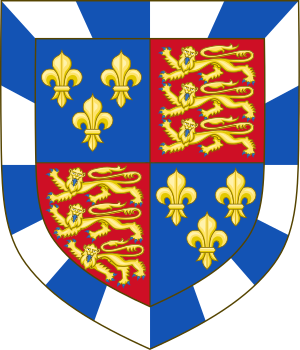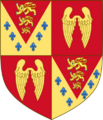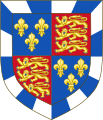Duke of Somerset facts for kids
Quick facts for kids Dukedom of Somerset |
|
|---|---|
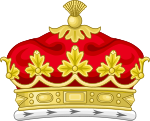 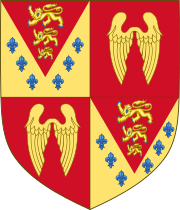
Arms of Seymour: Quarterly: 1st and 4th, Or on a Pile Gules between six Fleurs-de-Lis Azure three Lions of England (being the Augmentation of Honour granted by King Henry VIII on his marriage with Jane Seymour); 2nd and 3rd, Gules two Wings joined in lure the tips downwards Or (Seymour)
|
|
| Creation date | 1443 (first creation) 1448 (second creation) 1499 (third creation) 1547 (fourth creation) 1660 (fourth creation, restored) |
| Monarch | Henry VI (first creation) Henry VI (second creation) Henry VII (third creation) Edward VI (fourth creation) Charles II (fourth creation, restored) |
| Peerage | Peerage of England |
| First holder | John Beaufort, 3rd Earl of Somerset |
| Present holder | John Seymour, 19th Duke of Somerset |
| Heir apparent | Sebastian Seymour, Baron Seymour |
| Remainder to | the 1st Duke's heirs male of the body lawfully begotten |
| Subsidiary titles | Baron Seymour |
| Extinction date | 1444 (first creation) 1464 (second creation) 1471 (second creation, titular) 1500 (third creation forfeit) |
| Seat(s) | Bradley House Berry Pomeroy Castle |
| Former seat(s) | Bulstrode Park |
| Motto | Foy pour devoir (Faith for duty) |
The Duke of Somerset is a special title in England, named after the county of Somerset. This title has been created five times throughout history. It is most famously linked to two families: the Beauforts, who held it from 1448, and the Seymours, who have held it since 1547 and still do today.
The current Dukedom of Somerset is unique. The first person to hold this title created it for himself. He was the Lord Protector of England, a powerful role, and used a special power from his nephew, King Edward VI.
The Duke of Somerset has one smaller title, Baron Seymour. This title is used by the Duke's oldest son and future heir. Even though it's a lower-ranking title, the Baron Seymour is considered very important. This is because the Dukedom of Somerset is one of the oldest and most senior dukedoms in England. Only the Duke of Norfolk is considered more senior among non-royal dukes.
Many other titles have been held by Dukes of Somerset over time, but most of them no longer exist. For example, titles like Earl of Kendal, Earl of Hertford, and Marquess of Hertford were once held by these dukes.
The main home of the Duke of Somerset is Bradley House in Maiden Bradley, Wiltshire. They also have another historic estate called Berry Pomeroy Castle in Totnes, Devon. The Seymour family is usually buried at All Saints' Church, Maiden Bradley, which is right next to Bradley House.
Contents
History of the Dukes of Somerset
The title of Duke of Somerset has a long and interesting history, with different families holding it over the centuries.
The Beaufort Family Dukes
The Beaufort family was the first to hold the title of Duke of Somerset.
First Beaufort Creation (1443)
The first Duke of Somerset was John Beaufort (1404–1444). He was already the Earl of Somerset. King Henry VI made him a Duke in 1443. However, John Beaufort died without any sons, so this first dukedom ended in 1444.
Second Beaufort Creation (1448)
John Beaufort's brother, Edmund Beaufort (around 1406–1455), became the Earl of Somerset. King Henry VI then made him Duke of Somerset in 1448. Even though it was a new creation, he is often called the 2nd Duke of Somerset.
Edmund Beaufort was killed in the First Battle of St Albans in 1455. His son, Henry Beaufort (1436–1464), inherited the titles. Henry fought in the Wars of the Roses, a series of civil wars in England. After a major defeat in 1461, his titles and lands were taken away. They were briefly given back, but he was later captured and executed in 1464.
Henry Beaufort had no children who could legally inherit his titles. His brother, Edmund Beaufort (around 1439–1471), was still called Duke of Somerset by those who supported the Lancastrian side in the wars. However, he was also captured and executed in 1471. After his death, the main line of the Beaufort family ended.
Royal Family Dukes
The title was briefly given to members of the royal family.
Duke of Somerset (1499)
In 1499, King Henry VII named his baby son, Edmund, Duke of Somerset. But the child died very young, at just over a year old, and likely never officially received the title.
Duke of Richmond and Somerset (1525)
Later, Henry VIII had a son named Henry Fitzroy (1519–1536). In 1525, Henry Fitzroy was made Duke of Richmond and Somerset. He died without any children, so his titles also ended.
Earl of Somerset (1613)
Robert Carr (around 1590–1645) was a close friend of King James VI and I. In 1613, he was made Earl of Somerset. He died in 1645, leaving only a daughter, so his title also ended.
The Seymour Family Dukes
The Seymour family has held the Dukedom of Somerset for a long time, and they still hold it today.
First Seymour Creation (1547)
Edward Seymour, 1st Duke of Somerset (around 1500–1552) was the older brother of Jane Seymour, who was King Henry VIII's third wife. This made Edward the uncle of young King Edward VI. When Henry VIII died in 1547, Edward Seymour became the most powerful person in England, acting as the "Lord Protector" for the young king.
In 1547, Edward Seymour was made "Duke of Somerset." This title was linked to his family's old lands in Somerset. He also received a special addition to his family's coat of arms from Henry VIII. Edward Seymour had two marriages. The dukedom was set up to pass down through the sons from his second marriage.
In 1552, Edward Seymour lost his power and was executed. His titles were taken away.
Restored Dukedom (1660)
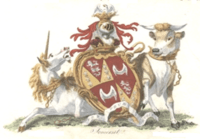
After a period when England was a republic, the monarchy was restored in 1660. The title of Duke of Somerset was given back to the Seymour family. William Seymour (1588–1660) was the great-grandson of the first Duke. He had supported King Charles I during the English Civil War. In 1660, shortly before his death, the dukedom was restored to him.
William Seymour outlived his three oldest sons. The dukedom then passed to his grandson, William Seymour (1650–1671). This 3rd Duke died without children. The title then went to his uncle, John Seymour (before 1646–1675), who was the last surviving son of the 2nd Duke. John also died without children.
The title then passed to a more distant cousin, Francis Seymour (1658–1678). He was the grandson of the 2nd Duke's younger brother. Francis also died young and without children.
His brother, Charles Seymour (1662–1748), became the 6th Duke. He was known as "the Proud Duke" and was a favorite of Queen Anne. He lived a long life and had a son, Algernon Seymour (1684–1750), who became the 7th Duke.
Algernon Seymour also died without any sons. Because of how the dukedom was set up, it then passed to a distant cousin, Edward Seymour (1695–1757). He was a descendant of the first Duke's second son. His family had moved their main home from Berry Pomeroy Castle to Bradley House.
Later Dukes of Somerset
The 8th Duke was followed by his sons, Edward Seymour (1717–1792) and then Webb Seymour (1718–1793). Webb's son, Edward Adolphus Seymour (1775–1855), became the 11th Duke. He was a famous mathematician. He changed the family name to St. Maur, though Seymour was still often used.
His son, Edward Adolphus Seymour (1804–1885), became the 12th Duke. He was given the additional title of Earl St. Maur in 1863. His eldest son, Edward A. F. Seymour (1835–1869), known as Ferdy, was an adventurer. He had two children with a maid, but they were not legally married. Because of this, his children could not inherit the dukedom.
The 12th Duke died in 1885, having outlived both of his sons. The title then passed to his younger brothers: Archibald Henry Algernon Seymour (1810–1891) and then Algernon Percy Banks St. Maur (1813–1894). Algernon's son, Algernon Seymour (1846–1923), became the 15th Duke. He died without children.
The title then went to a more distant cousin, Edward Hamilton Seymour (1860–1931). He was a great-great-grandson of the 8th Duke's youngest son. His son, Evelyn Francis Seymour (1882–1954), became the 17th Duke.
The title then passed to his son, Percy Hamilton Seymour (1910–1984). Today, the title is held by his son, John Michael Edward Seymour, who was born in 1952. The current heir, meaning the person who will inherit the title next, is Sebastian Edward Seymour, Lord Seymour, born in 1982.
Dukes of Somerset Lineage
This is a list of the Dukes of Somerset, showing how the title has passed down through the generations.
Dukes of Somerset, First Creation (1443)
- John Beaufort, 1st Duke of Somerset (1404–1444)
Dukes of Somerset, Second Creation (1448)
- Edmund Beaufort, 2nd Duke of Somerset (around 1406–1455)
- Henry Beaufort, 3rd Duke of Somerset (1436–1464)
- Edmund Beaufort, 4th Duke of Somerset (around 1438–1471)
Duke of Somerset, Third Creation (1499)
- Edmund Tudor, 1st Duke of Somerset (1499–1500)
Duke of Richmond and Somerset (1525)
- Henry FitzRoy, 1st Duke of Richmond and Somerset (1519–1536)
Dukes of Somerset, Fourth Creation (1547)
- Edward Seymour, 1st Duke of Somerset (around 1500–1552)
Dukes of Somerset, Fourth Creation Restored (1660)
- William Seymour, 2nd Duke of Somerset (1588–1660)
- William Seymour, 3rd Duke of Somerset (1650–1671)
- John Seymour, 4th Duke of Somerset (before 1646–1675)
- Francis Seymour, 5th Duke of Somerset (1658–1678)
- Charles Seymour, 6th Duke of Somerset (1662–1748)
- Algernon Seymour, 7th Duke of Somerset (1684–1750)
- Edward Seymour, 8th Duke of Somerset (1695–1757)
- Edward Seymour, 9th Duke of Somerset (1717–1792)
- Webb Seymour, 10th Duke of Somerset (1718–1793)
- Edward Adolphus St Maur, 11th Duke of Somerset (1775–1855)
- Edward Adolphus Seymour, 12th Duke of Somerset (1804–1885)
- Archibald Algernon Henry Seymour, 13th Duke of Somerset (1810–1891)
- Algernon Percy Banks St Maur, 14th Duke of Somerset (1813–1894)
- Algernon St Maur, 15th Duke of Somerset (1846–1923)
- Edward Hamilton Seymour, 16th Duke of Somerset (1860–1931)
- Evelyn Francis Edward Seymour, 17th Duke of Somerset (1882–1954)
- Percy Hamilton Seymour, 18th Duke of Somerset (1910–1984)
- John Michael Edward Seymour, 19th Duke of Somerset (born 1952)
The heir apparent is the present Duke's eldest son, Sebastian Edward Seymour, Lord Seymour (born 1982).
Current Line of Succession
After these individuals, the male heirs of the Marquess of Hertford are next in line to the dukedom.
Images for kids


